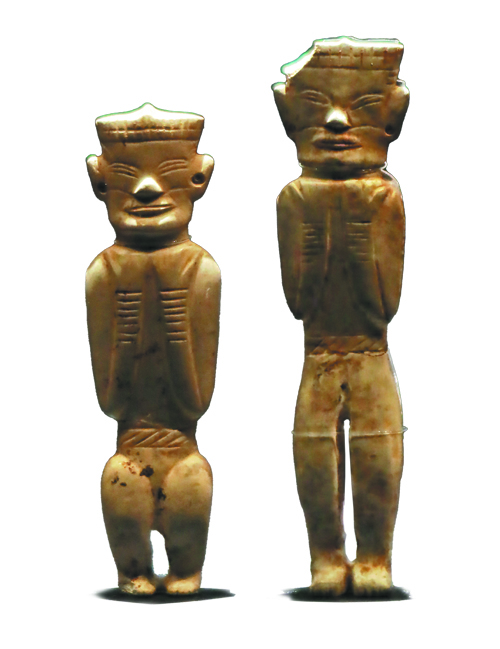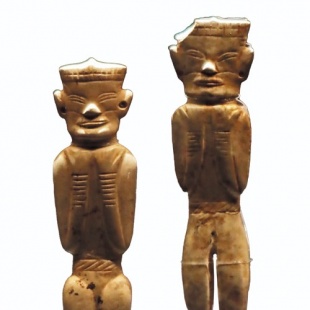Jade prospers as vanguard of civilization


The curator recalls a similar gesture found in other jade figurines of the Olmec culture in Mexico, despite the long distance and gap of time between them. Xu explains that ancestors share the same awe toward nature.
A jade eagle with identical forms and patterns on each side and two wings shaped like a pig's head is a highlighted item.
"It suggests that pigs were considered a symbol of wealth by the early inhabitants of Lingjiatan," Xu says, as large-sized jade pigs were also unearthed at the site.
"But another explanation could be that the two wings are chubby bears, and bears represent prowess in traditional culture," she adds.
Coincidentally or not, when the characters ying ("eagle") and xiong ("bear") are combined, they sound the same as yingxiong ("hero"). Combining eagles and bears is also a common theme in jade artifacts in later periods of Chinese history.
As there is still debate on which animal acts as a guard to the brave eagle, an octagonal star pattern carved on the eagle's belly further demonstrates its exceptional status.
This motif has been found on other jade artifacts from Lingjiatan and pottery pieces from elsewhere in China during the Neolithic era.
"This jade eagle was likely used in sacrificial rituals, showcasing the ancient people's reverence for the spiritual essence of all things and their highly imaginative creative spirit," the curator says.
"Lingjiatan artisans shaped jade into innovative symbolic forms. These creations embody their recognition of ritual authority and primal appreciation of beauty."
An exhibited tree-shaped ornament also shows an aura of sacredness. Its pattern resembles carved symbols dating back 7,000 years in another site in Bengbu and some brick paintings dating 3,000 years later than the Lingjiatan era unearthed in Huaibei. Both cities are in Anhui province.
If such a long lineage of regional totems needs more proof, some obvious evidence of long-distance communication has already stunned researchers of modern times.
Around 1,400 kilometers away to the north of Lingjiatan, Hongshan culture prospered during roughly the same era as Lingjiatan in present-day Northeast China. Similarities between the areas startled people and stirred many memories.
Both cultures tended to use jade as burial objects and built stone altars and tombs. More importantly, resemblances between the jades they carved — ranging from eagle, dragon, and crest-shaped artifacts to humans — cannot be explained as coincidence.
"When people first found cylindrical vessels at the sites of Hongshan culture, people argued how they were used and some even guessed they were pillows," Xu recalls.
Following the discovery of Lingjiatan, disputes soon ended as similar cylindrical vessels emerged together with jade divination sticks. The vessel shape is now believed to be an abstract portrayal of turtle shells.
"There must have been some exchanges among social elites between the two societies in which the division of social classes and combination of theocracy and kingship had formed," Xu explains.
"They showcased their unique splendor while engaged in mutual influence and interaction. ... They enriched the cultural landscape of ancient China."
Features of Lingjiatan jades were also seen in the Liangzhu culture in present-day Hangzhou, Zhejiang province. The Archaeological Ruins of Liangzhu City, a UNESCO World Heritage Site dating back 4,300 to 5,300 years, is admired as the capital of a jade-worshiping regional state also famous for its complicated water conservancy construction and rice-cultivation civilization.
"Lingjiatan was a pivotal position for tracing the origins of Chinese civilization and exploring how it developed," says Tang Jun, director of the administration of the Lingjiatan site. "This exhibition can better usher in academic fruits and connect similar sites across the country to promote joint studies."
The sands of time have not buried Lingjiatan in the public's collective memory. A ceremonial jade artifact from the site known as bi with concentric circles was used as the prototype for designing the medals presented at the Beijing 2022 Winter Olympics.
The vanguard of civilization is marching on in glory.





































